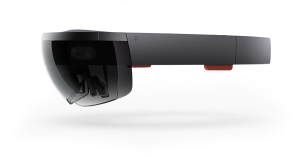Last month we saw the technical preview and unveiling of Microsoft’s new HoloLens technology. Basically an amazing piece of augmented reality technology that will reportedly be coming with the Windows 10 wave of products. It inserts computer generated content directly into the field of view with the HoloLens headset. A lot has been written on the experience and potential of the technology, and most are dropping it into the ‘vertical’ category of apps like Real Estate, CAD or gaming. I agree, HoloLens has the potential to be a game changer in these kinds of applications.
But that doesn’t need to be the only story. Recently we started getting requests at work for dual monitors. Being the cheapskate I am, we rolled it out first slowly to the people that would really use the extra space. But then I started thinking, having the extra space spread out allows people to get more work done and interact over a lot more applications at once rather than switching windows. HoloLens is kind of the ultimate expression of multi-monitor for Windows.
I can see a case to be made for a pure, Windows 10 based HoloLens without the vertical industry requirement. Just Windows expanded into you living room or work space. Imagine putting on the headset and logging in and having your start screen experience placed all over the room. Click on Netflix and a movie theater window opens at just the right distance in space. Media consumption becomes an immersive experience. Movies, music, even web browsing are all spread out around your environment. Cortana can float through the room and walk with you like a real assistant. Rather than at an uncomfortable desk, you can arrange your living room as a work/play space.
A working environment might have collections of Windows floating around your main app, diagrams on the desk, 3d models floating in air, Office applications to the side. Taken further, Windows no longer need to be confined to their old standard shapes and sizes. Alerts and notifications could be ‘pinned’ on farther surfaces showing big alerts at a distance while intimate work could be up close. The room and all it’s surfaces become the workspace. Walking around ‘inside’ your work becomes normal, walking up to a ‘white board’ can be on any wall, video calls can be in the desk or hover over the phone. Icons floating in space or live tiles (or cubes! let’s go 3d!) could be strategically placed. I would love a virtual envelope icon to pop up through my desk and sit there like an object for notifications. Along those lines, notifications take on an all new potential as virtual objects that appear when attention is needed. Add cool animation and 3d and you’re living in the future.
Most pundits currently talk about the potential for specialized use case scenarios for HoloLens, and this may turn out to be the case at first. But if you look at HoloLens as basically multiple monitors unleashed from hardware, it begins to take on something much more–and immediately useful. Microsoft would need only make some manner of positioning applications ready for the launch to ‘pin’ your environment, then leverage universal apps to populate your workspace. Make the price reasonable and you could start using it tomorrow.
Just a thought…
